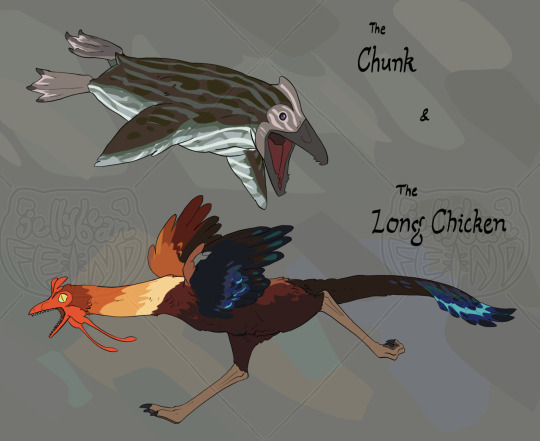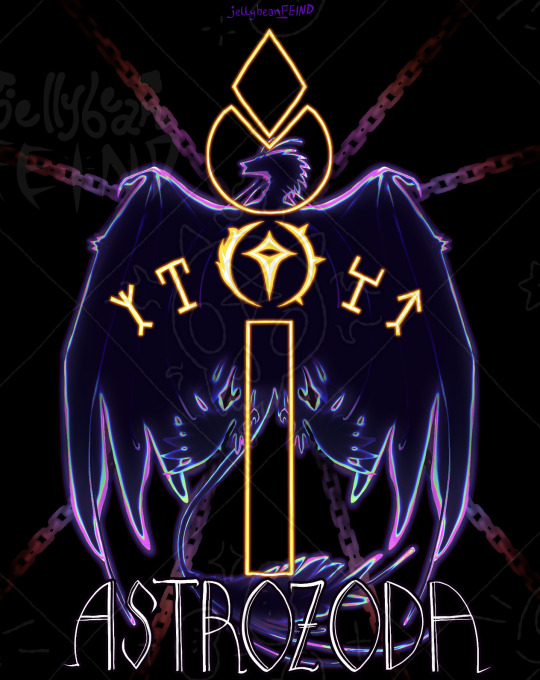#Astrozoda
Text

Magic in Astrozoda behaves less like an innate force of nature and more like a coding language that hasn’t been updated since it was originally written. This means that spellcrafting is an extremely powerful but extremely dangerous line of study; amazing discoveries have been made entirely on accident, but so have a lot of…less fortunate occurrences. But for every For loop that ends in catastrophic disaster, there are a dozen misspelt attributes or misread commands that lead to Astrozoda’s cultures, landscapes, and wildlife being peppered with the screw-ups of spellcrafters past. And chickens, being plentiful, are often tragic test subjects.
The cockatrice is among the most populous and ancient of these screw-ups. Whoever first made one did so well over five hundred years ago, so their exact intentions are unknown, but very few modern scholars entertain the idea that the cockatrice was what they were actually trying to make. Cockatrices can occur if a snake nests eggs in magically-enhanced henhouses, but with improvements to homesteading magic, this has become rare. Nonetheless, breeding populations of cockatrices are well-established in warm-temperate regions where poultry farms and wild snakes co-occur. In some of these regions, they have out-competed other mid-sized carnivores to the point that some areas have experienced local extinctions of foxes or bobcats.

The chunk and the long chicken are more modern in origin. Both are the work of (in)famous spellcrafter Atticus Owle, whose various discoveries (and screw-ups) over his career ended in his sudden disappearance about thirty years ago. Both of these animals were crafted with the original intention of increasing the meat output of domestic poultry without selective breeding to the point of debilitating deformity; he’d hoped that the long chicken in particular would replace the popular broiler chicken breed, and that the chunk would reduce hunting stress on ducks. Unfortunately, long chickens are far too dangerous to farm, and chunks are much better at hiding than ducks, in addition to not being any bigger.
The chunk lives in rivers and shallow lakes, where it hides close to the bottom to ambush prey that ventures too close. When no fish are nearby, chunks will swim slowly in the direction of the water’s flow, allowing their markings to help disguise their movement. Chunks beach only to nest, but they will rarely do so in the territories of humanoids; they are apparently quite intelligent, and only a few safe locations are known to hide their nests. Fishers in regions with established populations of chunks will often leave fishmeal bait a few hundred paces away from their fishing spots, to keep the birds well-sated so as to leave the largest fish for the fishers.
Long chickens are quite the mystery all of their own. The spell creating them was apparently supposed to simply create “large” chickens, but clearly, something went wrong. Owle reportedly hypothesized that chickens are descended of much larger animals, but in trying to unearth the supposed ancestor, made something far more difficult to farm. Long chickens are cooperative hunters, living in disorganized packs of around thirty individuals, and they primarily use their immense speed and high numbers to simply overwhelm prey animals. Though they are only about two feet tall at the shoulder, flocks of long chickens have reportedly been sighted felling moose.

Chittens and nuggets are the result of more elementary-level spellcrafting errors, but simplicity in the mistake does not equate simplicity in the consequences. Chittens were intended to be a sort of “designer” pet, to retain kitten-like cuteness its whole life and to come in a variety of colors. While they do certainly live up to this purpose, and indeed are very popular pets, feral populations are also now established, and these feral colonies have led to the discovery of some previously-unknown effects of their origins.
To dissuade potential animal abuse, a condition was written in their creation spell which could inflict immense dread upon someone knowingly harming a chitten. This had additional conditions attached to it, such that the condition would not affect anyone acting in self-defense, or in the chitten’s best interests, or for the safety of others, but these components were written in less-stable terms, and some feral populations of chittens have become nearly impossible to remove as a result. Even local predators cannot face them; wolves living near feral chitten colonies not only avoid chittens, but they secondarily will avoid anything that looks or smells like one. This has led to some interesting changes in these areas, where cuteness has converged on an aposematic condition, and other prey animals will mimic the round head and colorful eyes of a chitten to avoid being eaten.
Nuggets, on the other hand, are harmlessly filling an ecological niche they found completely on accident. Like every other animal featured here, nuggets were created on accident by a spellcrafter’s poor proofreading, however they have no exceptional features that endow them with the ability to out-compete much of anything. They’re basically hamsters. Conveniently enough, their invention coincided with a terrible plague which had devastated a small region’s populations of mice and squirrels. Releasing nuggets into the area prevented the drop in rodent population from negatively impacting higher trophic levels, and now they are a staple worldwide, as common as mice.
More “important” information on Astrozoda to come, I was just possessed by the need to make sure these chickens were seen.
#feind’s artwork#feind's worldbuilding#Astrozoda#chicken#cockatrice#long chicken#chunk#chitten#nugget#speculative biology#specbio#speculative zoology#worldbuilding
162 notes
·
View notes
Text
I've spent most of the day today organizing a lot of my headworld stuff that was in various disparate locations to all be in ONE scrivener document because im literally insane and I like being able to jump back and forth between projects like that lol
This whole task (as well as recent admiration of a bunch of artists on here) has led to me REALLY getting the itch to start like. actually posting headworld content and lore. So like...obv tumblr doesn't have a poll function but based on description & name alone which setting should I start with lol
🌟 Astrozoda: High fantasy af, mid-1800's technology level, what with the humans and elves and Established Gods and all that. This is the one where I have like 20+ pages of dragon lore and biology that I wrote before I knew I was autistic lol
🌟 Grandwyld: Science-fantasy I guess?? Lot of speculative evolution & in-depth cultural notes. Little bit of wizard battles and eldritch horrors, little bit of laser guns and thermonuclear devastation. This setting has the greatest volume of material because I've been writing it since I was literally 12 lmao
🌟 Uurth: Like Earth but a little fucked up. The concept is basically that it's a timeline that is closely parallel to ours, but the thread of it is...y'know, a little wonky. There's some new animals. Neurotypes are an established biological mechanism of humans. Cryptids also. I have the least amount of written lore for this setting, and yet somehow the most stories, like four stories take place in the "modern" version of Uurth and two take place in the distant future lol
Anyways if one of these tickles your fancy leave a comment or an ask or whatever bc when I am faced with decisions I simply Do Not Make Them lol
3 notes
·
View notes
Text

Final ionogrph taken of Atticus Owle, with research colleague Kotyn Mist and their last test subject.
The circumstances of his disappearance baffled the academic world of Astrozoda for years. Mist, herself a well-decorated spellcrafter, had taken up collaboration with Owle to research the origins of certain species. Inspired by Owle’s previous fiasco with long chickens, she hypothesized that lizards and birds may share a common ancestor, and further wondered how Astrozodan fae are related to one another, and to other life in Astrozoda.
Through blood testing and lumiotyping— the study of magical signatures left by different groups of magical creatures— Mist and Owle discovered that the jewel-like eyes of unicorns and fae were not merely coincidental. Mist confirmed that the magical signature of her own blood, and indeed the blood of other equisapiens, was strikingly similar to that of pixies and fairies. And with Owle’s mastery of biological alchemy, the two spellcrafters collaborated to combine the “deep fae” lumiotype into a mundane domestic horse in an attempt to catch a glimpse of what ancient equisapiens may have looked like.
The above ionograph depicts the resulting test subject: a colt with pink and white hair, a horn, and the typical elongated features and jewel-like eyes seen in extant fae. Interestingly, it also has a trait not seen in any known fae: in addition to the expected auditory antennae, it has mandibular antennae as well. The purpose of these extra antennae was unknown to Mist and Owle, and according to their research logs, they intended to investigate the matter, but Owle’s sudden disappearance put an end to any further experiments.
Owle’s laboratory was found vacant of crafter and crafts, and Mist was found wandering the mountains several miles away, disoriented and suffering a magical injury which would force her into an early retirement.
#feind’s artwork#digital art#feind's worldbuilding#Astrozoda#Atticus Owle#Kotyn Mist#unicorn#speculative biology#speculative magic
29 notes
·
View notes
Text

And the final setting card (for now), Astrozoda!
A high-fantasy realm of magic and monsters, Astrozoda is populated by a variety of humanoids, and it is also the home plane of true dragons. In recent decades, technology and magic have grown more together, and the Transglobal Railway has set the path to a new era of advancements in science and sorcery. Political tensions between Astrozoda's many city-states are hesitant, however, and the roles of the various churches and guilds seem to have ulterior motives.
6 notes
·
View notes
Text


One of the best things about getting back into these worldbuilding projects is getting to revisit some of these species through a new lens. Grandwyld was always a magical realm, but I have really enjoyed exploring the speculative evolution side of things and leaving the more "typical" high fantasy stuff for Astrozoda, just to offer more differentiation between the realms.
This is the newest version of a maristelle, one of the five fae native to Grandwyld. Basal life in Grandwyld, for the most part, features four-sided radial symmetry from "face" end to "butt" end, but many more advanced species secondarily developed bilateral symmetry as well, as is the case in the maristelle and its ancestors. It has four limbs on each major junction of its body, as well as four eyes (two Proper eyes on the dorsal side vs two simpler photoreceptors on the ventral side) and four antennae/ears.
This one is naked, but inhabitants of Grandwyld do wear clothes--I mostly just wanted to make sure y'all could see his lil grabby arms. The individual here is probably about six feet tall at the shoulder.
I'll do a more in-depth study of the deep phylogeny of Grandwyld at a later point, but maristelles come from an evolutionary lineage not dissimilar to earthly birds, though their most recent ancestor likely filled an ecological niche that one would expect from an omnivorous giraffe capable of powered flight. Short bursts of speed ambush-chase predator, otherwise chewing on whatever random crap they can find lying around the plateaus.
#feind’s sketchbook#feind's worldbuilding#grandwyld#maristelles#speculative evolution#specbio#speculative biology#specevo#worldbuilding#speculative phylogeny#science fantasy
137 notes
·
View notes